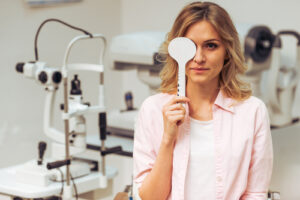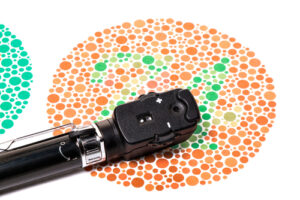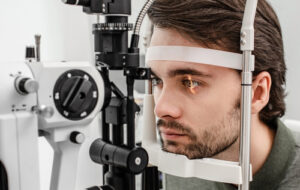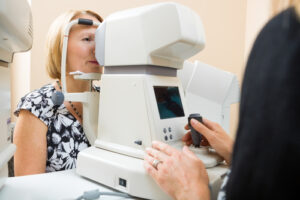The best way to keep your eyes healthy is to schedule a yearly routine eye exam. At Batra Vision, we offer comprehensive routine eye care exams. These test your vision and screen for specific eye conditions and diseases.
Routine eye exams ensure you have the most up-to-date vision prescription. They can also detect vision-threatening eye conditions and diseases, like glaucoma, retinal holes, and cataracts.
Often asymptomatic and painless in their early stages, these eye conditions and diseases can damage your vision over time. Early detection and treatment of these eye conditions and diseases lead to better treatment outcomes.
What to Expect at Your Routine Eye Exam
The first thing your Batra Vision eye doctor will do at a routine eye exam is to review your health history. They’ll ask you questions about any health problems or conditions that you may have or any that may have developed since your last eye exam. Certain health conditions, like diabetes, can affect your eyes.
They may also ask about your family’s health history. Your answers to these questions can help your ophthalmologist know if there are any specific hereditary eye conditions or diseases for which you may be at risk.
These may include glaucoma or certain eye cancers, like retinoblastoma. After reviewing your health and health history, your eye doctor will perform standard tests to check your vision and how healthy your eyes are. Standard tests during a routine eye exam include the following:
Visual Acuity Test

The visual acuity test determines how well you can see, with and without corrective lenses. If you already wear eyeglasses or contact lenses, this test checks if your prescription is current prescription or needs changes.
During this test, your ophthalmologist will ask you to read letters on an eye chart (also called a Snellen chart). Covering one eye at a time, your provider will ask you to read the letters on the chart.
They will then ask you to read the same letters on the chart while looking through a phoropter. The phoropter contains lenses of different strengths to determine whether you need corrective lenses to see clearly. This is a process called refraction.
If a patient is a young child or has trouble communicating, the eye doctor can use an autorefractor to measure visual acuity. This device shines a light into the eye, measuring the eye’s response.
Visual Field Test

A visual field test checks your peripheral or side vision. Your eye doctor performs this test by holding up a finger or other object. They slowly move it from one side of your face to the other, up and down, and then closer to your face.
You’ll follow this object using only your eyes during this test. This test shows your eye doctor your entire range of vision.
Color Vision Test

A color vision test checks for color blindness and your ability to see the difference between colors. Your eye doctor will show you a series of images composed of colored dots.
Within these dots are hidden numbers in different colors, which they’ll ask you to name. If you have a color deficiency, you may not be able to see the numbers.
Ophthalmoscopy and Slit-Lamp Examination
Your eye doctor at Batra Vision uses ophthalmoscopy and slit-lamp examination (also called a fundoscopy) to examine the structures inside your eyes. These procedures allow them to examine your cornea, lens, retina, optic nerve, and surrounding blood vessels for signs or symptoms of potential degeneration or disease.

Your ophthalmologist will dilate your pupils using special eye drops for these two tests. Once your pupils have dilated enough, your eye doctor will perform ophthalmoscopy, using a handheld instrument to shine a light into your eye, examining your eye structures.
While your pupils are dilated, they will perform a slit-lamp examination. Your eye doctor will ask you to rest your chin and forehead on the slit-lamp device, a microscope attached to a table.
The slit-lamp test allows your eye doctor to have a closer, more detailed view of the eye structures examined in the ophthalmoscopy procedure. The effects of pupil dilation can last a few hours, including blurry vision and increased sensitivity to light.
You should wear sunglasses that protect against UV rays if you are out in the sun, and avoid driving, reading, and looking at screens until your pupils return to normal.
Tonometry Test

The tonometry test measures the pressure inside your eye. This test is mainly to screen for glaucoma, a serious eye condition that can lead to vision impairment.
With your chin and forehead resting against the slit lamp device, your ophthalmologist will blow a small puff of air directly onto your cornea. Observing how much the air flattens the cornea can determine if your eye is maintaining the correct amount of pressure.
All the tests performed during a routine eye exam are painless. A typical routine eye exam takes about 30 to 45 minutes to complete.
The Outcome of Your Routine Eye Exam

The information from these tests ensures your eye doctor can offer the treatments you need to maintain your vision. After a routine eye exam, if your eye doctor determines you need corrective lenses, they will discuss your options.
You may want to opt for a beautiful pair of glasses, the convenience of contact lenses, or LASIK. Whatever you choose, Batra Vision can provide the solution that works best for you.
If your eye doctor detects signs of an eye condition, Batra Vision can offer you the most advanced techniques and treatments. We’re here to keep your eyes healthy. Our knowledgeable eye care providers will work with you to develop a treatment plan that addresses your individual needs.
At Batra Vision, we believe that comprehensive, routine eye exams are the best way to ensure that your vision remains clear and your eyes stay healthy. We offer routine eye exams at our three offices in the East Bay area, making routine eye care easy and convenient!
Do you need an eye exam? Schedule yours at Batra Vision in San Leandro, CA, today!

 Follow Us!
Follow Us!